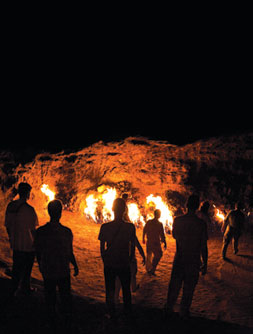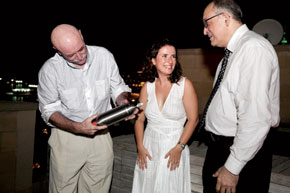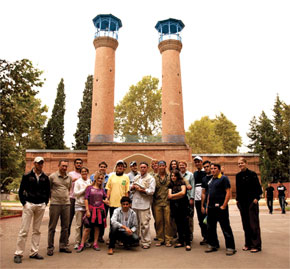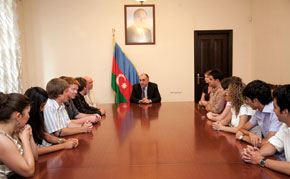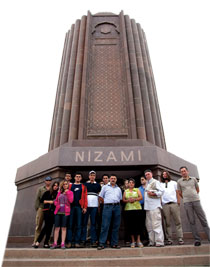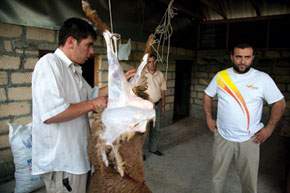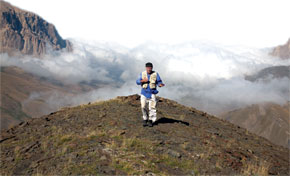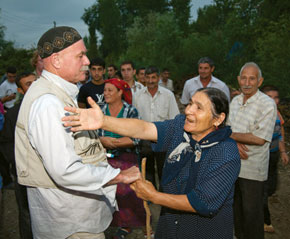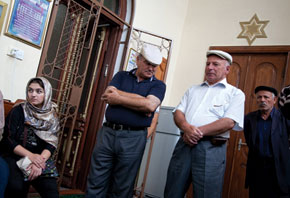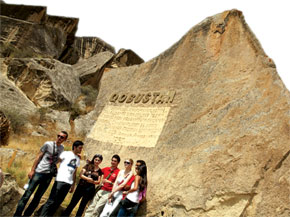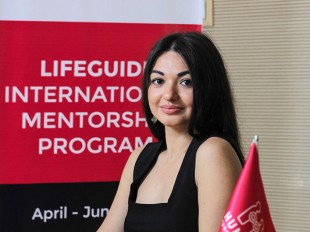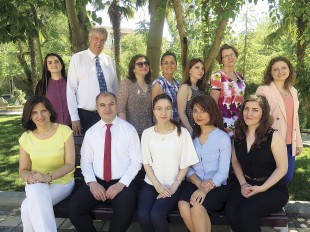Pages 16-23
By Thomas Goltz
PART ONE: PROLOGUE, AZERBAIJAN AND GEORGIA
PROLOGUE: January 3, 2010, Istanbul:
It all began on an early January winter evening in Istanbul, when I met with a couple of old friends from the Turkish energy sector to talk about old times.
Specifically, we were chatting about the grand adventure known as ‘The Oil Odyssey,’ when at the command of the late, great president of Azerbaijan, I and a group of mad-men (and women) carried the first symbolic barrel of Azerbaijani crude oil down the proposed but-still-to-be-sanctioned Baku-Tbilisi-Ceyhan (BTC) main crude oil export pipeline route that would link the energy riches of the Caspian to the Mediterranean and thus the larger world. Our delivery vehicles were old 650 CC URAL-type three wheeler motorcycles, with one stripped of its sidecar carriage to carry the 60-gallon drum.
“Ten years!” chuckled Gokhan Bildaci, the then-BOTAS General Director, but now an independent energy trader. “What could they have done without us?”
Then, after a pause, Gokhan’s erstwhile assistant, Dr Professor Cenk Pala, turned to me and quietly said:
“Thomas Bey—we must do it again…”
I had no idea what he was talking about, and said so.
“Another international energy adventure!” he hoarsely whispered. “It is time…”
What Cenk Pala was trying to get me to do was organize an eye-catching event associated with the new ‘pipeline to nowhere’ project known as Nabucco, a multi-billion dollar natural gas deal to which he had helped give a name. The twists and turns of said project are epic in the context of the cut-throat international oil & gas industry. But from the moment that Cenk tried to engage me in the organization of a new BTC-like venture, it quickly became evident that calling it an NGO (Nabucco/Gas Odyssey) was premature.
Or over the top,
For starters, an initial survey of original 2000 Oil Odyssey survivors suggested that even calling the 2010 event an ‘Oil Odyssey Ten Years After’ would not be accurate. In addition to those hearty participants being a decade older, our original flock of URAL bikes was also ten-years on, and could not be said to have been kept in the best repair.
More to the point, former sponsors pointed out that ANY 2010 energy journey had to be ‘green,’ as in ecologically-friendly. By definition, this put the smoke-belching, 76-Octane URAL at an extreme disadvantage as being the symbolic delivery vehicle of choice for a Clean Gas For Europe odyssey.
There were, of course, electrical/green bike options sent to me by ‘alert readers,’ and many were really cool. But all shared the same fundamental problem, namely, that they were all experimental. In the absence of some corporation forking over at least a part of the necessary funding, the New Silk Road/Nabucco Gas Odyssey 2010 seemed dead in the water.
Ah, well.
‘If they don’t want it, I shall not build it,’ I said - or something to that effect to an audience of students taking my diplomatic simulation class based on the Organization of the Black Sea Economic Cooperation, or BSEC, at Montana State University (MSU), sharing the trials and travails of wasting my semester break organizing a new Oil Odyssey.
“It is over,” quoth I.
“But Professor,” said one of the students. “This is what we have been studying with you - the BTC, Nabucco, Azerbaijan, Georgia, Turkey. Create a summer school course for us, please!”
Serendipity, as she will, had suddenly struck--and it was sublime.
To hell with the motorcycle crowd - that was ten years earlier!
I had no idea what the most of the other crowd from 2000, 2001 or 2002 were doing, but I had carved a new life for myself as an adjunct professor of deeply obscure but eminently important stuff.
Yes - this was the project I had been waiting for: The New Silk Road---Adventures in Energy and the Environment.
And the core would be made up of my for-credit students from Montana State University, coupled with an international brigade of Azerbaijanis, Turks and Georgians, whether they liked it or not.
Let this diary and the pictures do the talking.
Thomas Goltz, Livingston, Montana, October 16, 2010
Day One/Aug 14 Arrival in Baku: After 36 sleepless hours in Istanbul, the MSU team arrives in Baku aboard a complementary red-eye AzAl flight to be escorted to two lovely boutique hotels in Baku’s “Icheri Sheher,” or Inner City. After a few hours’ sleep, they are joined by students from Baku’s Western (‘Garb’) University to a take a tour of the almost car-free old town of meandering cobblestone lanes, hosted by the Icheri Sheher administration. Elnur, a refugee youth from a camp in the Barda district will, join the group later that night at the grand opening reception at the historic Karavansaray restaurant for a feast attended by NSRS sponsors and friends numbering almost 80; it ends with a concert by Qochaq Asgerov and his Mugham ensemble, who mesmerize all
Day Two/Aug 15: Orientation Day: The NSRS youth are bused to Gobustan national park to view ancient cave paintings and mud volcanoes, returning in the afternoon to the Martyrs’ Lane cemetery for a talk about the Qarabagh conflict by NSRS team leader and self-described ‘Herder of Cats’ (henceforth ‘HoC’), namely me. The Foreign Ministry-supplied-bus then takes the crowd to beach dinner sponsored by BakCell telephone provider; a special drop-in guest is Sonuj Alizade, brother of Yalchin Alizade, the former TASS correspondent who first brought the HoC to Azerbaijan in the summer of 1991. The evening ends with 10 pm visit to “Burning Mountain” – the natural gas leak that has been burning for thousands of years.
Day Three/Aug 16: Energy day. The youth are given a geological tour, lunch and visit to the massive Sangachal oil/gas terminal south of Baku by non-official sponsor BP and an evening meal/discussion sponsored by David Skeels of RWE, accompanied by walking oil and energy encyclopedia Richard Pegge, the only translator mentioned in Heydar Aliyev’s memoires. A lively Q & A follows, special focus on Nabucco; the team then moves to Gilan Holding’s Qafqaz Point hotel.
Day Four/Aug 17: SOCAR Environmental Day. The youth tour various SOCAR environmental facilities, including a rehabilitated oil field. They are invited to symbolically plant trees before attending a reception with SOCAR brass hosted by Dr Elshad Nassirov at the former Nobel Brothers’ residence, now restored and a museum. A special guest is John Roberts of Platts Oilgram News, who has joined the group that day as an in-house expert; he is mightily impressed with basic knowledge of MSU crowd.
Day Five/Aug 18: Foreign Ministry Day. The youth are welcomed at the Azerbaijan Diplomatic Academy by Rector H.E. Ambassador Hafiz Pashayev, followed by tour of current ADA building and visual tour of future ADA campus. Lectures on “Energy and Crisis” by Dr Elnur Soltanov and “East-West Transportation Networks” by Taleh Ziyadov follow. After lunch, the group is received at the Foreign Ministry by Deputy Minister Araz Azimov for a lecture on Karabagh realities and then a private, spontaneous meeting with Foreign Minister Elmar Mammedyarov. The NSRS then gathers for a send-off BBQ soiree on AZChAM director Nargiz Nasrullayeva-Muduroglu’s roof-top patio and the official presentation of the ‘Azerbaijani gas for Europe’ canister by Elshad Nassirov. The football-sized canister (under 150 bar of pressure, appropriately dubbed ‘the gas-bomb’) is symbolic: SOCAR is saying that it wants its Azerbaijani gas to go to Europe, and not Asia.
Day Six/Aug 19: Ecology Day. The two new Mercedes ‘Sprinter’ buses and a command car provided by TEAS point man Taleh Baghiyev await the team outside the Qafqaz Point for the ride up to Quba via St Hizir’s Shrine on the Caspian shore. After a lunch at a table sagging with Azerbaijani traditional food, the team moves up mountain for a tent camp set next to a natural gas fire, followed by a discussion of environmental issues with Minister for Ecology Dr Huseyn Bagirov at 2,500 meters. The change of altitude from sea-level knocks most out, but relief from heat is a great pleasure, as is Dr Bagirov, who conducts a candid two hour Question and Answer session about environmental issues facing Azerbaijan—and there are plenty!
Day Seven/Aug 20: Shah Dagh Day. The NSRS shifts to a new Meteorological Station inside Shah Dagh National Park on Russian frontier and at 2,800 meters, after a spine-wrenching ride over non-roads with sheer drops into deep canyons. After lunch, about half the group take a six-hour trek/climb up to a 3,400 meter sub-peak, where Steven Babbit, Richard Gauron, Will Getchell and muscular ex-Marine Daniel Brooks show the other climbers the finer points of the art of ‘trundling,’ which means getting boulders to roll down hill. A near-full moon rises over surrounding craggy peaks (the highest of which is Tufan Mountain at 4,751 meters) and the oxygen-deprived team collapses into deep sleep.
Day Eight/Aug 21: Guba and Qabala Day. The (early) morning is a wild, wild white-knuckle drive down-mountain with ranger Shaboli leading the way with foot to the floor, because his Ecology Ministry team has been summoned to a forest fire in Qabala on the far side of the mountains. It may be 30 miles as crows fly, but it is 300 miles or so by road. The NSRS team checks in with local officials in Quba city, who set up nice meeting with Mountain Jewish community and the so-called Genocide Museum, dedicated to a hill of recently discovered remains of Azeri victims of ethnic cleansing from 1918. It is heavy stuff. Then it is off to Qabala via Sumgait, arriving at around 5 PM with water-bearing helicopters still buzzing overhead, but a thundershower threatening a grand and welcome deluge to put out the fire naturally. The team checks into hotels provided by TEAS and make contact with Hikmet Gayibov for a traditional Muslim Iftar, or breaking of the Ramadan fast, followed by highly nuanced discussion about Islam’s role in Azerbaijan and the world. A small contingent from the MSU team decide to camp in tents next to beautiful lake, and snore until dawn beneath the drizzle left after the torrential rain that put out the forest fire.
Day Nine/Aug 22: Long Day of Extremes. After breakfast, the NSRS tours the Gilan Holding Jala Juice factory sampling dozens of different juices; crates of the stuff are loaded on the buses and will be consumed all the way into Turkey. The planned departure to visit the Caucasian Albanian/Udi town of Nijj and its nearly 2,000 year-old (recently restored) Christian church, serving community of 3,000 believers ends in a short, meaningful discussion about the differences between the Orthodox Udi/Albanian rite and that of the Apostolic Armenians, in whose church the Udis were subsumed by Czarist decree in 1838. Daniel Brooks recites the Lord’s Prayer in Udi. The NSRS has thus had meetings with three religious communities within 24 hours—the Mountain Jews of Quba, the Muslim iftar with Hikmet in Qabala and the Christian Udis of Nijj.
The caravan moves on to what might be the most emotional moment of the entire trip—the arrival at the Four Corners Barda refugee camp where fellow-traveler Elnur Muharramov once dwelled, followed by a convoy reception at his parent’s house in new settlement on the zero-zone of the front lines where Armenian and Azerbaijani forces face each other. The local governor insists that NSRS stops in Barda for a meal and Mugham performance, stretching a very long day well into the night.
Day Ten/Aug 23: Tovus and Ganira Day. After a breakfast of farm eggs and bread with the Garanboy governor, NSRS pushes on to Ganja to visit the tomb/memorial of 12th century national poet Nizami Ganjavi and the Shah Abbas mosque. Shopping for trinkets delays departure despite Member of Parliament Ganira Pashayeva demanding haste in getting to her home province Tovus, where she has prepared a full day of activities. These include a front-line tour of non-Karabagh Armenian aggression against Azerbaijan - literally standing on recently torched grasslands, a long lunch and political discussion with the local governor over kebabs, a tour of new archeological excavations conducted by Japanese experts of a 6th century BC settlement and then a two hour, open-air “Ramadan” concert by Baku pop stars.
Day Eleven, Aug 24: Qazakh to Tbilisi. After a hearty breakfast, the NSRS heads to Qazakh on the Georgian frontier. The town seems to have produced more famous people per capita (writers, poets, artillery specialists etc) than any other in Azerbaijan, and boasts busts and statues in their honor in the charming square. It is also home to Aygun Husseinli, a student at the Azerbaijan Diplomatic Academy and our unofficial guide. Aygun is officially an IDP, or Internally Displaced Person (refugee) due to the fact that her town in Qazakh province was a real “enclave,” meaning a chunk of territorial Azerbaijan that was inside Armenia until overrun and occupied in the early stages of the Armenian-Azerbaijan conflict (notably outside Karabagh itself). The conflict has touched her in a very personal way: she showed us a fountain on the main street with a stone engraving of her aunt, a national hero of Azerbaijan, who declared that she would not leave the village while under attack in order to shame the men into staying to defend it. Aygun’s aunt used her last bullet on herself, lest she fall into enemy hands, which she relates with cold, proud clarity.
Then, with tears in many an eye, most of the Azerbaijani students embrace their new American friends from Montana and turn back to Baku while the MSU contingent pushes on toward the Georgian frontier. It has been an utterly intense eleven days in the Land of Az - but it is not yet even half way across the grueling, three week New Silk Road Summer odyssey. Next: Georgia On My Mind…
Taylor Bezek
8-15-2010
Culture shock has never resonated more with me than it has the last two days, eleven time zones and several thousand miles, and on the opposite face of the planet from Bozeman, Montana. The land of fire greeted us with heat and humidity after our redeye flight from Istanbul to Baku, having only a class-fed idea of what to expect of this Caspian oil town, I was pleasantly surprised by what met us here. A strong sense of nationalism accompanied by outstanding hospitality with a blend of luxury and historical charm are a few of the many things Azerbaijan has shown me in my 48 hours within her borders.
After hitting the ground running at Heydar Aliev International and buzzing through the somewhat spirit-crushing Soviet-era settlements that dot the landscape into Baku, we arrive in our hotel and are allowed a short nap to take the edge off. Post nap, and post wandering, arbitrary nosing about solo, it was off to a tour around the old town including the Palace of the Shirvanshahs and Maidens Tower. During the heat of the day, I believe Logan Brown described the climate best when he said it was “hotter than love in August” out there, which I could not disagree with. At dinner I found myself sitting with people from stories from past classes, good food, and even better live entertainment, I felt as though I was sitting in every video Goltz had presented to us over the last year.
`Qobustan and the mud volcanoes were the destination of day two in the “New Silk Road” expedition. First I have to say that the conversations on both the way to and from the attractions were nearly as gratifying as the attractions themselves. Intense interviews with subject ranging from school to politics to sports dominated the time spent in transit. “How do you like Azerbaijan?” naturally came at me more than once, at which point I would jokingly answer “I’m warming up to it” and point to my sweat stained shirt, afterwards proceeding to get into conversation about notable cultural and historical aspect of the country. From mugham to mudpots, whether I’ve been burning my ass off (literally) in front of eternal flames or cooling off under the shade of Martyrs Lane, Baku and Azerbaijan has so far proved to be much more than I could have imagined.
Laura Villegas
Martyrs’ Lane
The Martyrs’ Lane Cemetery in Baku has been dedicated to those patriotic heroes killed by the Soviet Army during the crack-down of the first independence movements of January, 1991 and expanded massively by those who fell in the war with Armenia since the conflict over the occupied territories started. The open spaces and widespread design of the site give the visitor a sense of dynamism, rather than emptiness. Not only are visitors allowed to walk around a beautiful if deeply sad garden, but also they are expected to allow their spirit to wander around freely.
The melancholy in the atmosphere feeds the memory of the living with the histories of the dead. The buried corpses are more the seeds of national identity than the bodies of dead heroes. The site is more a ground for cultivation than a cemetery; here, the earth is pregnant with the seeds of hate, love, passion, irrationality, discipline, conviction, confusion, and national nostalgia.
At the site there is also a monument to the fire of the burning souls of Azerbaijanis. The eternal Flame memorial at Martyrs’ lane arguably represents the strength, stubbornness and devotion characteristic of the Azerbaijani soul. If souls are made out of something, Azerbaijani souls are clearly made out of natural gas. They only need to be lighted in order to burn forever—whether they burn inside their original holder is a different question.
Taylor Bezek
SOCAR Eco parks and Nobel House Dinner
On August 17 the “New Silk Road Expedition” was hosted by the State Oil Company of the Azerbaijani Republic (SOCAR)’s ecological division, which took our student contingent around actual ecological projects being undertaken by the company. There is no doubt that the Absheron peninsula and the Caspian Sea surrounding it is polluted, primarily due to the Soviet “no holds barred” approach to extracting oil for the last hundred years. SOCAR, at least in theory, seems to attempting to change that habit and trying to curtail and even reverse the adverse effects on the environment associated with the energy industry. “Oil is welfare, but nature is life” was the message the heads of the state oil company had for us, and they were prepared to show us why. A digital presentation outlining SOCAR’s ecological initiatives led to a visit of two ecological parks where the company was attempting to plant trees on arid land that was previously polluted by decades of harmful oil extraction practices. All of the expeditionary crew, including myself, had the privilege of planting a symbolic tree in a section of one of the parks. From stands of freshly planted trees we were off to a reclamation facility built for the purpose of neutralizing and recycling crude oil waste in the ground and the water surrounding the Absheron peninsula. It was an impressive facility, complete with large settling pools, processing tanks and separators designed to get every drop out of the reclaimed waste. Still, after having been witness to Azerbaijan’s attempts clean up the area, I am hesitant to say that that concern for ecological security is on par with concern for pumping as much oil as possible; that said, it seems that SOCAR has taken at least the first step in being environmentally responsible. The trees may die and the reclamation plant may only be recycling a fraction of a percent of the pollution, but the fact of the matter is that SOCAR has put a foot in the right direction with regard to the environment. Seeing firsthand the comforts oil can bring, it is hard to imagine why SOCAR would want to focus on anything other than getting it out of the ground and on the market. Even putting forth the façade that environmental protection is on the SOCAR radar is leaps and bounds beyond environmental policies of the past.
Jokes and geopolitics from the boys at SOCAR filled the air of the historic “Villa Petrolea” house and estate of the Nobel brothers where we were put up for a fine dinner later that evening. The living monument to the early oil tycoons, the house (replete with multiple dining rooms, dance floor, grand piano, oriental room, and other comforts) is now once again used by SOCAR as the preferred venue to conduct negotiations. We were fortunate (or unfortunate depending on the way you look at it) enough to show up for dinner just as a set of negotiations (Nabucco?) were wrapping up; we were not privy to the details…
I will not soon forget talking football and James Bond flicks with Elshad Nassirov, head of SOCAR’s foreign investments division, and our host that evening. Our visit to the Nobel house showed how important oil and natural gas has been and continues to be in the area, along with the luxuries the black gold has afforded those living there.
Daniel Brooks
The New Silk Road
Shahdag National Park
The road led to an open valley protected on all sides by massive mountain peaks clothed in fluffy white clouds. Crossing a river, our convoy ran into a confrontation with the vicious Anatolian Sheep Dogs that have been trained to remain loyal to only one master… After finishing yet another Azerbaijani feast, I packed some water and other hiking essentials to begin the ascent towards the largest peak in Azerbaijan at 4,466 meters (13,500 feet) high. We had been beneath sea-level the day before. Huff-puff… Approximately 2/3 of the way to our pinnacle ridge, we got the group together to engage in the simple and satisfying sport/activity known as ‘trundling,’ namely, rolling boulders off precipices. A good trundle depends on the amount of energy you are willing to expend, meaning how high and steep you go before selecting your disposable rock to trundle down the mountain. In our case, we hit a minor summit (circa 3,500 meters) to catch our breath and immediately went to work searching for the perfect trundling stones to hurl. Perhaps the excitement of watching circular rocks roll, whack and dive down hill—maybe a vertical mile (OK, 1,000 feet) if done correctly--was due to our exhaustion after achieving above-cloud altitude in the Shah Daghi range. But so what--it was enjoyable to see the boulders crash and crash and crash, and watch the clouds dance beneath our feet.
By definition, the descent was easier than the lung-blowing ascent, although not without problems: our self-styled ‘dictator’ ran out of all steam, and nearly died.
Serves him right, flatlander.. Me, I shall remember climbing Shah Daghi and the epic trundle forever.
Laura Villegas
Qabala, August 22th.
History has determined the importance of Qabala as a center of archeology; however, today, Qabala not only is an important geographical reference to historians, it is a center of culture and economic growth. Today, Qabala is the home a new International Music Festival, and if you follow football and remember the legendary defender at the UK Arsenal team, Tony Adams, you will know that Qabala is also the home of the professional football team, Qabala FC. The pleasant climate and the natural scenery of the province make Qabala a popular tourist destination in Azerbaijan. Also, it enjoys prime climatic conditions for agriculture; chestnuts and hazelnut trees are easily found around the city and province. While the economy of Qabala is mainly agricultural, new industries are staring to proliferate.
Today, we had the opportunity to visit the facilities of one of the successful pioneer industries of the modern country of Azerbaijan--the Jala Juice factory. Despite the fact that it was Sunday (the plant works 24/7) we had the chance to walk around the brand-new facilities in the company of its director, a certain Mr Suleyman. What we saw included the storehouse with its tall stalks of fruit juice boxes; the rooms where all the shiny, stainless steel Italian and Swedish machinery guarantees standard, efficient and quick production; and the rooms with the huge metallic pots where the actual fruit is processed.
After our tour of the plant, we were invited to the sampling station. There are dozens and dozens of different juice products, from pure nectar to cognac. There is jala of all sorts of fruits I never heard of, and that’s a lot to say because I come from a tropical climate (Columbia), and I am not used to not knowing the name of half the fruits in the market. Then my eyes spot a black box of Feyxoa Nektari and I was immediately transported to a place far, far away called Cota, where a loving father was in the orchard picking the first ripe feijoas of harvesting season…
I made my way to the juice bar and demanded a glass of feijoa jala, and soon had in my hands a convex glass filled with a very intriguing grayish-yellowish liquid that was going to take me on a trip to a special place far away in space and time. I close my eyes and, like Dorothy of the Wizard of Oz fame, repeated, “there is no place like home,” and start to sipping the mysterious potion.
I am 8 years old again; it is a typical sunny and hot day of January in Columbia. I have a blue dress, which could easily be a cheap green sweat suit, and I am pouring little stones of fertilizer into the holes my dad has been digging this morning. For the past couple hours, my dad, my 5-year old sister and I have been working arduously in getting the terrain ready for cultivation. We are going to plant 30 trees of feijoas and some more bushes of blackberries in the parcel annexed to the garden. Trees are much cooler than seasonal plants like sunflowers and corn, because trees actually stay with you for many, many years and are reliable friends. On top of that, feijoas are probably the smartest choice of tree to plant because they are the most delicious fruit that can exist. the orchard boasts 33 feijoa trees along with oaks, walnuts, acacias, guayacans, papayuelas, figs, blackberries, tamarillo fruits, and more. The feijoas though, are the hosts of the party, their delicious fruits bring all kinds of insects, birds and rodents to the garden…
Twice a year, we harvest feijoas; they rain from the trees like water from the sky. There are so many of them that we cannot find enough friends to give them to. So of course, for about 2 months in a row, twice a year, we drink feijoa juice for breakfast, we take it to school, we drink it again for lunch, and for dinner. My mom makes a delicious feijoa marmalade so that we can store the goodness of the fruit for months and months. If there is a social event, we bring feijoa cake. And if you just feel like snacking on something, grab a fruit from the ground: it is delicious.
So, here I am in Qabala, Azerbaijan, drinking feijoa juice at the Jala factory together with 20 students of 3 different nationalities.
The verdict: my mom makes it better.
Daniel Brooks
The New Silk Road
The Wealth/Poverty Gap
Elnur painted a picture of everyday life growing up with thousands of refugees, but the moment it hit was when he brought us to a solitary bush, still growing tall amongst a background of emptiness, which he had planted as a young boy and which remains a landmark of where he once lived. Solemnly, we headed back to the buses to venture onward towards the current refugee camp and Elnur’s residence.
Getting off the bus, we were swarmed by refugees; it was a culture shock incomparable even to my experiences in Iraq. We made a quick stop at Elnur’s aunt’s house to say, “marhaba,” and let Elnur display his new friends to his family members. Then, upon reaching his new residence, we were greeted with plates of bread, vegetables, and of course, chai. Even with food in front of us, only a couple could fill our well-fed American stomachs with food more appropriately destined for the rumbling bellies of the people that live day to day with no more than the hope of returning to their homeland.
It is easy to get distracted and upset about the state of affairs for Karabagh refugees and demand that the government of Azerbaijan work more to rectify the situation. This paradox of affluence versus poverty happens all over the world, and very visibly in the United States as well. Furthermore, it is hard not to consider the entire population of Native Americans as internally displaced persons who will never regain tribal power over their original homelands.
It would be nice to see the Azerbaijani government do more for the refugee population, but illusory to expect it to do so.
Taylor Bezek
9-3-2010
Until August 22nd the conflict in the semi-autonomous region of mountainous Karabagh was no more than a topic of class discussion. Over the last year we have read about and talked about the ongoing “frozen conflict” between Azerbaijan and Armenia, now we had a chance to investigate it firsthand. Going to refugee settlements with our guide and internally displaced person, Elnur Merrehemov, we got an intimate look at the backlash caused by the on-again off-again war with Armenia.
The first stop of the day was to the site that previously housed some 9000 IDP’s dubbed “four roads” tent camp, which Elnur was forced to call home after his village was overrun when he was twelve years old. Two by two meter tents plots often housing families of five dotted a total area no larger than my college campus (Montana State) at only a few acres. Stories of many dying due to heat in the summer and terrible cold were told emotionally as we strolled through the now empty field. Our guide was noticeably anxious to leave four roads and not till up any more memories.
Next on the docket were semi-permanent, somewhat more hospitable settlements that some refugees were placed in after their villages fell into Armenian hands. Characterized by bamboo fences, blue U.N. tarps, and small brick abodes, these complexes were by no means luxurious but a vast improvement on the harsh conditions of the tent camp. Those who got to call this place home after being displaced were referred to as the lucky ones.
As night fell we departed finally for Elnur’s current home, government provided permanent homes. On the way we passed by stationary train cars that were oddly lit up though not connected to an engine on either end, only later to find out that those train cars also served as housing for the currently displaced. We arrived at Elnur’s home close to nightfall were greeted by yet another huge step up from the living conditions we had seen previously. Complete with running water, steady electricity, a yard, and a small storage shed, was a home away from home. The key is “away from home” and that is exactly how the situation is viewed by all those who are displaced. This sentiment was only made clearer when we were ushered out as night fell because we were only 3km from the Armenian lines and that meant lights out as to not draw any attention to the area.
All in all a heavy day for the “New Silk Road” expedition, and one not soon to be forgotten, meeting those affected by the Nagorno-Karabakh conflict was quite a trip.. To go from reading about a conflict like this one to seeing its toll firsthand changed my perspective completely. The term “frozen-conflict” no longer holds any significance in my mind with regards to Karabagh. There are people struggling every day, people like Elnur who haven’t gone home in over a decade, who know that this conflict is anything but frozen.
By Thomas Goltz
PART ONE: PROLOGUE, AZERBAIJAN AND GEORGIA
PROLOGUE: January 3, 2010, Istanbul:
It all began on an early January winter evening in Istanbul, when I met with a couple of old friends from the Turkish energy sector to talk about old times.
Specifically, we were chatting about the grand adventure known as ‘The Oil Odyssey,’ when at the command of the late, great president of Azerbaijan, I and a group of mad-men (and women) carried the first symbolic barrel of Azerbaijani crude oil down the proposed but-still-to-be-sanctioned Baku-Tbilisi-Ceyhan (BTC) main crude oil export pipeline route that would link the energy riches of the Caspian to the Mediterranean and thus the larger world. Our delivery vehicles were old 650 CC URAL-type three wheeler motorcycles, with one stripped of its sidecar carriage to carry the 60-gallon drum.
“Ten years!” chuckled Gokhan Bildaci, the then-BOTAS General Director, but now an independent energy trader. “What could they have done without us?”
Then, after a pause, Gokhan’s erstwhile assistant, Dr Professor Cenk Pala, turned to me and quietly said:
“Thomas Bey—we must do it again…”
I had no idea what he was talking about, and said so.
“Another international energy adventure!” he hoarsely whispered. “It is time…”
What Cenk Pala was trying to get me to do was organize an eye-catching event associated with the new ‘pipeline to nowhere’ project known as Nabucco, a multi-billion dollar natural gas deal to which he had helped give a name. The twists and turns of said project are epic in the context of the cut-throat international oil & gas industry. But from the moment that Cenk tried to engage me in the organization of a new BTC-like venture, it quickly became evident that calling it an NGO (Nabucco/Gas Odyssey) was premature.
Or over the top,
For starters, an initial survey of original 2000 Oil Odyssey survivors suggested that even calling the 2010 event an ‘Oil Odyssey Ten Years After’ would not be accurate. In addition to those hearty participants being a decade older, our original flock of URAL bikes was also ten-years on, and could not be said to have been kept in the best repair.
More to the point, former sponsors pointed out that ANY 2010 energy journey had to be ‘green,’ as in ecologically-friendly. By definition, this put the smoke-belching, 76-Octane URAL at an extreme disadvantage as being the symbolic delivery vehicle of choice for a Clean Gas For Europe odyssey.
There were, of course, electrical/green bike options sent to me by ‘alert readers,’ and many were really cool. But all shared the same fundamental problem, namely, that they were all experimental. In the absence of some corporation forking over at least a part of the necessary funding, the New Silk Road/Nabucco Gas Odyssey 2010 seemed dead in the water.
Ah, well.
‘If they don’t want it, I shall not build it,’ I said - or something to that effect to an audience of students taking my diplomatic simulation class based on the Organization of the Black Sea Economic Cooperation, or BSEC, at Montana State University (MSU), sharing the trials and travails of wasting my semester break organizing a new Oil Odyssey.
“It is over,” quoth I.
“But Professor,” said one of the students. “This is what we have been studying with you - the BTC, Nabucco, Azerbaijan, Georgia, Turkey. Create a summer school course for us, please!”
Serendipity, as she will, had suddenly struck--and it was sublime.
To hell with the motorcycle crowd - that was ten years earlier!
I had no idea what the most of the other crowd from 2000, 2001 or 2002 were doing, but I had carved a new life for myself as an adjunct professor of deeply obscure but eminently important stuff.
Yes - this was the project I had been waiting for: The New Silk Road---Adventures in Energy and the Environment.
And the core would be made up of my for-credit students from Montana State University, coupled with an international brigade of Azerbaijanis, Turks and Georgians, whether they liked it or not.
Let this diary and the pictures do the talking.
Thomas Goltz, Livingston, Montana, October 16, 2010
Day One/Aug 14 Arrival in Baku: After 36 sleepless hours in Istanbul, the MSU team arrives in Baku aboard a complementary red-eye AzAl flight to be escorted to two lovely boutique hotels in Baku’s “Icheri Sheher,” or Inner City. After a few hours’ sleep, they are joined by students from Baku’s Western (‘Garb’) University to a take a tour of the almost car-free old town of meandering cobblestone lanes, hosted by the Icheri Sheher administration. Elnur, a refugee youth from a camp in the Barda district will, join the group later that night at the grand opening reception at the historic Karavansaray restaurant for a feast attended by NSRS sponsors and friends numbering almost 80; it ends with a concert by Qochaq Asgerov and his Mugham ensemble, who mesmerize all
Day Two/Aug 15: Orientation Day: The NSRS youth are bused to Gobustan national park to view ancient cave paintings and mud volcanoes, returning in the afternoon to the Martyrs’ Lane cemetery for a talk about the Qarabagh conflict by NSRS team leader and self-described ‘Herder of Cats’ (henceforth ‘HoC’), namely me. The Foreign Ministry-supplied-bus then takes the crowd to beach dinner sponsored by BakCell telephone provider; a special drop-in guest is Sonuj Alizade, brother of Yalchin Alizade, the former TASS correspondent who first brought the HoC to Azerbaijan in the summer of 1991. The evening ends with 10 pm visit to “Burning Mountain” – the natural gas leak that has been burning for thousands of years.
Day Three/Aug 16: Energy day. The youth are given a geological tour, lunch and visit to the massive Sangachal oil/gas terminal south of Baku by non-official sponsor BP and an evening meal/discussion sponsored by David Skeels of RWE, accompanied by walking oil and energy encyclopedia Richard Pegge, the only translator mentioned in Heydar Aliyev’s memoires. A lively Q & A follows, special focus on Nabucco; the team then moves to Gilan Holding’s Qafqaz Point hotel.
Day Four/Aug 17: SOCAR Environmental Day. The youth tour various SOCAR environmental facilities, including a rehabilitated oil field. They are invited to symbolically plant trees before attending a reception with SOCAR brass hosted by Dr Elshad Nassirov at the former Nobel Brothers’ residence, now restored and a museum. A special guest is John Roberts of Platts Oilgram News, who has joined the group that day as an in-house expert; he is mightily impressed with basic knowledge of MSU crowd.
Day Five/Aug 18: Foreign Ministry Day. The youth are welcomed at the Azerbaijan Diplomatic Academy by Rector H.E. Ambassador Hafiz Pashayev, followed by tour of current ADA building and visual tour of future ADA campus. Lectures on “Energy and Crisis” by Dr Elnur Soltanov and “East-West Transportation Networks” by Taleh Ziyadov follow. After lunch, the group is received at the Foreign Ministry by Deputy Minister Araz Azimov for a lecture on Karabagh realities and then a private, spontaneous meeting with Foreign Minister Elmar Mammedyarov. The NSRS then gathers for a send-off BBQ soiree on AZChAM director Nargiz Nasrullayeva-Muduroglu’s roof-top patio and the official presentation of the ‘Azerbaijani gas for Europe’ canister by Elshad Nassirov. The football-sized canister (under 150 bar of pressure, appropriately dubbed ‘the gas-bomb’) is symbolic: SOCAR is saying that it wants its Azerbaijani gas to go to Europe, and not Asia.
Day Six/Aug 19: Ecology Day. The two new Mercedes ‘Sprinter’ buses and a command car provided by TEAS point man Taleh Baghiyev await the team outside the Qafqaz Point for the ride up to Quba via St Hizir’s Shrine on the Caspian shore. After a lunch at a table sagging with Azerbaijani traditional food, the team moves up mountain for a tent camp set next to a natural gas fire, followed by a discussion of environmental issues with Minister for Ecology Dr Huseyn Bagirov at 2,500 meters. The change of altitude from sea-level knocks most out, but relief from heat is a great pleasure, as is Dr Bagirov, who conducts a candid two hour Question and Answer session about environmental issues facing Azerbaijan—and there are plenty!
Day Seven/Aug 20: Shah Dagh Day. The NSRS shifts to a new Meteorological Station inside Shah Dagh National Park on Russian frontier and at 2,800 meters, after a spine-wrenching ride over non-roads with sheer drops into deep canyons. After lunch, about half the group take a six-hour trek/climb up to a 3,400 meter sub-peak, where Steven Babbit, Richard Gauron, Will Getchell and muscular ex-Marine Daniel Brooks show the other climbers the finer points of the art of ‘trundling,’ which means getting boulders to roll down hill. A near-full moon rises over surrounding craggy peaks (the highest of which is Tufan Mountain at 4,751 meters) and the oxygen-deprived team collapses into deep sleep.
Day Eight/Aug 21: Guba and Qabala Day. The (early) morning is a wild, wild white-knuckle drive down-mountain with ranger Shaboli leading the way with foot to the floor, because his Ecology Ministry team has been summoned to a forest fire in Qabala on the far side of the mountains. It may be 30 miles as crows fly, but it is 300 miles or so by road. The NSRS team checks in with local officials in Quba city, who set up nice meeting with Mountain Jewish community and the so-called Genocide Museum, dedicated to a hill of recently discovered remains of Azeri victims of ethnic cleansing from 1918. It is heavy stuff. Then it is off to Qabala via Sumgait, arriving at around 5 PM with water-bearing helicopters still buzzing overhead, but a thundershower threatening a grand and welcome deluge to put out the fire naturally. The team checks into hotels provided by TEAS and make contact with Hikmet Gayibov for a traditional Muslim Iftar, or breaking of the Ramadan fast, followed by highly nuanced discussion about Islam’s role in Azerbaijan and the world. A small contingent from the MSU team decide to camp in tents next to beautiful lake, and snore until dawn beneath the drizzle left after the torrential rain that put out the forest fire.
Day Nine/Aug 22: Long Day of Extremes. After breakfast, the NSRS tours the Gilan Holding Jala Juice factory sampling dozens of different juices; crates of the stuff are loaded on the buses and will be consumed all the way into Turkey. The planned departure to visit the Caucasian Albanian/Udi town of Nijj and its nearly 2,000 year-old (recently restored) Christian church, serving community of 3,000 believers ends in a short, meaningful discussion about the differences between the Orthodox Udi/Albanian rite and that of the Apostolic Armenians, in whose church the Udis were subsumed by Czarist decree in 1838. Daniel Brooks recites the Lord’s Prayer in Udi. The NSRS has thus had meetings with three religious communities within 24 hours—the Mountain Jews of Quba, the Muslim iftar with Hikmet in Qabala and the Christian Udis of Nijj.
The caravan moves on to what might be the most emotional moment of the entire trip—the arrival at the Four Corners Barda refugee camp where fellow-traveler Elnur Muharramov once dwelled, followed by a convoy reception at his parent’s house in new settlement on the zero-zone of the front lines where Armenian and Azerbaijani forces face each other. The local governor insists that NSRS stops in Barda for a meal and Mugham performance, stretching a very long day well into the night.
Day Ten/Aug 23: Tovus and Ganira Day. After a breakfast of farm eggs and bread with the Garanboy governor, NSRS pushes on to Ganja to visit the tomb/memorial of 12th century national poet Nizami Ganjavi and the Shah Abbas mosque. Shopping for trinkets delays departure despite Member of Parliament Ganira Pashayeva demanding haste in getting to her home province Tovus, where she has prepared a full day of activities. These include a front-line tour of non-Karabagh Armenian aggression against Azerbaijan - literally standing on recently torched grasslands, a long lunch and political discussion with the local governor over kebabs, a tour of new archeological excavations conducted by Japanese experts of a 6th century BC settlement and then a two hour, open-air “Ramadan” concert by Baku pop stars.
Day Eleven, Aug 24: Qazakh to Tbilisi. After a hearty breakfast, the NSRS heads to Qazakh on the Georgian frontier. The town seems to have produced more famous people per capita (writers, poets, artillery specialists etc) than any other in Azerbaijan, and boasts busts and statues in their honor in the charming square. It is also home to Aygun Husseinli, a student at the Azerbaijan Diplomatic Academy and our unofficial guide. Aygun is officially an IDP, or Internally Displaced Person (refugee) due to the fact that her town in Qazakh province was a real “enclave,” meaning a chunk of territorial Azerbaijan that was inside Armenia until overrun and occupied in the early stages of the Armenian-Azerbaijan conflict (notably outside Karabagh itself). The conflict has touched her in a very personal way: she showed us a fountain on the main street with a stone engraving of her aunt, a national hero of Azerbaijan, who declared that she would not leave the village while under attack in order to shame the men into staying to defend it. Aygun’s aunt used her last bullet on herself, lest she fall into enemy hands, which she relates with cold, proud clarity.
Then, with tears in many an eye, most of the Azerbaijani students embrace their new American friends from Montana and turn back to Baku while the MSU contingent pushes on toward the Georgian frontier. It has been an utterly intense eleven days in the Land of Az - but it is not yet even half way across the grueling, three week New Silk Road Summer odyssey. Next: Georgia On My Mind…
Taylor Bezek
8-15-2010
Culture shock has never resonated more with me than it has the last two days, eleven time zones and several thousand miles, and on the opposite face of the planet from Bozeman, Montana. The land of fire greeted us with heat and humidity after our redeye flight from Istanbul to Baku, having only a class-fed idea of what to expect of this Caspian oil town, I was pleasantly surprised by what met us here. A strong sense of nationalism accompanied by outstanding hospitality with a blend of luxury and historical charm are a few of the many things Azerbaijan has shown me in my 48 hours within her borders.
After hitting the ground running at Heydar Aliev International and buzzing through the somewhat spirit-crushing Soviet-era settlements that dot the landscape into Baku, we arrive in our hotel and are allowed a short nap to take the edge off. Post nap, and post wandering, arbitrary nosing about solo, it was off to a tour around the old town including the Palace of the Shirvanshahs and Maidens Tower. During the heat of the day, I believe Logan Brown described the climate best when he said it was “hotter than love in August” out there, which I could not disagree with. At dinner I found myself sitting with people from stories from past classes, good food, and even better live entertainment, I felt as though I was sitting in every video Goltz had presented to us over the last year.
`Qobustan and the mud volcanoes were the destination of day two in the “New Silk Road” expedition. First I have to say that the conversations on both the way to and from the attractions were nearly as gratifying as the attractions themselves. Intense interviews with subject ranging from school to politics to sports dominated the time spent in transit. “How do you like Azerbaijan?” naturally came at me more than once, at which point I would jokingly answer “I’m warming up to it” and point to my sweat stained shirt, afterwards proceeding to get into conversation about notable cultural and historical aspect of the country. From mugham to mudpots, whether I’ve been burning my ass off (literally) in front of eternal flames or cooling off under the shade of Martyrs Lane, Baku and Azerbaijan has so far proved to be much more than I could have imagined.
Laura Villegas
Martyrs’ Lane
The Martyrs’ Lane Cemetery in Baku has been dedicated to those patriotic heroes killed by the Soviet Army during the crack-down of the first independence movements of January, 1991 and expanded massively by those who fell in the war with Armenia since the conflict over the occupied territories started. The open spaces and widespread design of the site give the visitor a sense of dynamism, rather than emptiness. Not only are visitors allowed to walk around a beautiful if deeply sad garden, but also they are expected to allow their spirit to wander around freely.
The melancholy in the atmosphere feeds the memory of the living with the histories of the dead. The buried corpses are more the seeds of national identity than the bodies of dead heroes. The site is more a ground for cultivation than a cemetery; here, the earth is pregnant with the seeds of hate, love, passion, irrationality, discipline, conviction, confusion, and national nostalgia.
At the site there is also a monument to the fire of the burning souls of Azerbaijanis. The eternal Flame memorial at Martyrs’ lane arguably represents the strength, stubbornness and devotion characteristic of the Azerbaijani soul. If souls are made out of something, Azerbaijani souls are clearly made out of natural gas. They only need to be lighted in order to burn forever—whether they burn inside their original holder is a different question.
Taylor Bezek
SOCAR Eco parks and Nobel House Dinner
On August 17 the “New Silk Road Expedition” was hosted by the State Oil Company of the Azerbaijani Republic (SOCAR)’s ecological division, which took our student contingent around actual ecological projects being undertaken by the company. There is no doubt that the Absheron peninsula and the Caspian Sea surrounding it is polluted, primarily due to the Soviet “no holds barred” approach to extracting oil for the last hundred years. SOCAR, at least in theory, seems to attempting to change that habit and trying to curtail and even reverse the adverse effects on the environment associated with the energy industry. “Oil is welfare, but nature is life” was the message the heads of the state oil company had for us, and they were prepared to show us why. A digital presentation outlining SOCAR’s ecological initiatives led to a visit of two ecological parks where the company was attempting to plant trees on arid land that was previously polluted by decades of harmful oil extraction practices. All of the expeditionary crew, including myself, had the privilege of planting a symbolic tree in a section of one of the parks. From stands of freshly planted trees we were off to a reclamation facility built for the purpose of neutralizing and recycling crude oil waste in the ground and the water surrounding the Absheron peninsula. It was an impressive facility, complete with large settling pools, processing tanks and separators designed to get every drop out of the reclaimed waste. Still, after having been witness to Azerbaijan’s attempts clean up the area, I am hesitant to say that that concern for ecological security is on par with concern for pumping as much oil as possible; that said, it seems that SOCAR has taken at least the first step in being environmentally responsible. The trees may die and the reclamation plant may only be recycling a fraction of a percent of the pollution, but the fact of the matter is that SOCAR has put a foot in the right direction with regard to the environment. Seeing firsthand the comforts oil can bring, it is hard to imagine why SOCAR would want to focus on anything other than getting it out of the ground and on the market. Even putting forth the façade that environmental protection is on the SOCAR radar is leaps and bounds beyond environmental policies of the past.
Jokes and geopolitics from the boys at SOCAR filled the air of the historic “Villa Petrolea” house and estate of the Nobel brothers where we were put up for a fine dinner later that evening. The living monument to the early oil tycoons, the house (replete with multiple dining rooms, dance floor, grand piano, oriental room, and other comforts) is now once again used by SOCAR as the preferred venue to conduct negotiations. We were fortunate (or unfortunate depending on the way you look at it) enough to show up for dinner just as a set of negotiations (Nabucco?) were wrapping up; we were not privy to the details…
I will not soon forget talking football and James Bond flicks with Elshad Nassirov, head of SOCAR’s foreign investments division, and our host that evening. Our visit to the Nobel house showed how important oil and natural gas has been and continues to be in the area, along with the luxuries the black gold has afforded those living there.
Daniel Brooks
The New Silk Road
Shahdag National Park
The road led to an open valley protected on all sides by massive mountain peaks clothed in fluffy white clouds. Crossing a river, our convoy ran into a confrontation with the vicious Anatolian Sheep Dogs that have been trained to remain loyal to only one master… After finishing yet another Azerbaijani feast, I packed some water and other hiking essentials to begin the ascent towards the largest peak in Azerbaijan at 4,466 meters (13,500 feet) high. We had been beneath sea-level the day before. Huff-puff… Approximately 2/3 of the way to our pinnacle ridge, we got the group together to engage in the simple and satisfying sport/activity known as ‘trundling,’ namely, rolling boulders off precipices. A good trundle depends on the amount of energy you are willing to expend, meaning how high and steep you go before selecting your disposable rock to trundle down the mountain. In our case, we hit a minor summit (circa 3,500 meters) to catch our breath and immediately went to work searching for the perfect trundling stones to hurl. Perhaps the excitement of watching circular rocks roll, whack and dive down hill—maybe a vertical mile (OK, 1,000 feet) if done correctly--was due to our exhaustion after achieving above-cloud altitude in the Shah Daghi range. But so what--it was enjoyable to see the boulders crash and crash and crash, and watch the clouds dance beneath our feet.
By definition, the descent was easier than the lung-blowing ascent, although not without problems: our self-styled ‘dictator’ ran out of all steam, and nearly died.
Serves him right, flatlander.. Me, I shall remember climbing Shah Daghi and the epic trundle forever.
Laura Villegas
Qabala, August 22th.
History has determined the importance of Qabala as a center of archeology; however, today, Qabala not only is an important geographical reference to historians, it is a center of culture and economic growth. Today, Qabala is the home a new International Music Festival, and if you follow football and remember the legendary defender at the UK Arsenal team, Tony Adams, you will know that Qabala is also the home of the professional football team, Qabala FC. The pleasant climate and the natural scenery of the province make Qabala a popular tourist destination in Azerbaijan. Also, it enjoys prime climatic conditions for agriculture; chestnuts and hazelnut trees are easily found around the city and province. While the economy of Qabala is mainly agricultural, new industries are staring to proliferate.
Today, we had the opportunity to visit the facilities of one of the successful pioneer industries of the modern country of Azerbaijan--the Jala Juice factory. Despite the fact that it was Sunday (the plant works 24/7) we had the chance to walk around the brand-new facilities in the company of its director, a certain Mr Suleyman. What we saw included the storehouse with its tall stalks of fruit juice boxes; the rooms where all the shiny, stainless steel Italian and Swedish machinery guarantees standard, efficient and quick production; and the rooms with the huge metallic pots where the actual fruit is processed.
After our tour of the plant, we were invited to the sampling station. There are dozens and dozens of different juice products, from pure nectar to cognac. There is jala of all sorts of fruits I never heard of, and that’s a lot to say because I come from a tropical climate (Columbia), and I am not used to not knowing the name of half the fruits in the market. Then my eyes spot a black box of Feyxoa Nektari and I was immediately transported to a place far, far away called Cota, where a loving father was in the orchard picking the first ripe feijoas of harvesting season…
I made my way to the juice bar and demanded a glass of feijoa jala, and soon had in my hands a convex glass filled with a very intriguing grayish-yellowish liquid that was going to take me on a trip to a special place far away in space and time. I close my eyes and, like Dorothy of the Wizard of Oz fame, repeated, “there is no place like home,” and start to sipping the mysterious potion.
I am 8 years old again; it is a typical sunny and hot day of January in Columbia. I have a blue dress, which could easily be a cheap green sweat suit, and I am pouring little stones of fertilizer into the holes my dad has been digging this morning. For the past couple hours, my dad, my 5-year old sister and I have been working arduously in getting the terrain ready for cultivation. We are going to plant 30 trees of feijoas and some more bushes of blackberries in the parcel annexed to the garden. Trees are much cooler than seasonal plants like sunflowers and corn, because trees actually stay with you for many, many years and are reliable friends. On top of that, feijoas are probably the smartest choice of tree to plant because they are the most delicious fruit that can exist. the orchard boasts 33 feijoa trees along with oaks, walnuts, acacias, guayacans, papayuelas, figs, blackberries, tamarillo fruits, and more. The feijoas though, are the hosts of the party, their delicious fruits bring all kinds of insects, birds and rodents to the garden…
Twice a year, we harvest feijoas; they rain from the trees like water from the sky. There are so many of them that we cannot find enough friends to give them to. So of course, for about 2 months in a row, twice a year, we drink feijoa juice for breakfast, we take it to school, we drink it again for lunch, and for dinner. My mom makes a delicious feijoa marmalade so that we can store the goodness of the fruit for months and months. If there is a social event, we bring feijoa cake. And if you just feel like snacking on something, grab a fruit from the ground: it is delicious.
So, here I am in Qabala, Azerbaijan, drinking feijoa juice at the Jala factory together with 20 students of 3 different nationalities.
The verdict: my mom makes it better.
Daniel Brooks
The New Silk Road
The Wealth/Poverty Gap
Elnur painted a picture of everyday life growing up with thousands of refugees, but the moment it hit was when he brought us to a solitary bush, still growing tall amongst a background of emptiness, which he had planted as a young boy and which remains a landmark of where he once lived. Solemnly, we headed back to the buses to venture onward towards the current refugee camp and Elnur’s residence.
Getting off the bus, we were swarmed by refugees; it was a culture shock incomparable even to my experiences in Iraq. We made a quick stop at Elnur’s aunt’s house to say, “marhaba,” and let Elnur display his new friends to his family members. Then, upon reaching his new residence, we were greeted with plates of bread, vegetables, and of course, chai. Even with food in front of us, only a couple could fill our well-fed American stomachs with food more appropriately destined for the rumbling bellies of the people that live day to day with no more than the hope of returning to their homeland.
It is easy to get distracted and upset about the state of affairs for Karabagh refugees and demand that the government of Azerbaijan work more to rectify the situation. This paradox of affluence versus poverty happens all over the world, and very visibly in the United States as well. Furthermore, it is hard not to consider the entire population of Native Americans as internally displaced persons who will never regain tribal power over their original homelands.
It would be nice to see the Azerbaijani government do more for the refugee population, but illusory to expect it to do so.
Taylor Bezek
9-3-2010
Until August 22nd the conflict in the semi-autonomous region of mountainous Karabagh was no more than a topic of class discussion. Over the last year we have read about and talked about the ongoing “frozen conflict” between Azerbaijan and Armenia, now we had a chance to investigate it firsthand. Going to refugee settlements with our guide and internally displaced person, Elnur Merrehemov, we got an intimate look at the backlash caused by the on-again off-again war with Armenia.
The first stop of the day was to the site that previously housed some 9000 IDP’s dubbed “four roads” tent camp, which Elnur was forced to call home after his village was overrun when he was twelve years old. Two by two meter tents plots often housing families of five dotted a total area no larger than my college campus (Montana State) at only a few acres. Stories of many dying due to heat in the summer and terrible cold were told emotionally as we strolled through the now empty field. Our guide was noticeably anxious to leave four roads and not till up any more memories.
Next on the docket were semi-permanent, somewhat more hospitable settlements that some refugees were placed in after their villages fell into Armenian hands. Characterized by bamboo fences, blue U.N. tarps, and small brick abodes, these complexes were by no means luxurious but a vast improvement on the harsh conditions of the tent camp. Those who got to call this place home after being displaced were referred to as the lucky ones.
As night fell we departed finally for Elnur’s current home, government provided permanent homes. On the way we passed by stationary train cars that were oddly lit up though not connected to an engine on either end, only later to find out that those train cars also served as housing for the currently displaced. We arrived at Elnur’s home close to nightfall were greeted by yet another huge step up from the living conditions we had seen previously. Complete with running water, steady electricity, a yard, and a small storage shed, was a home away from home. The key is “away from home” and that is exactly how the situation is viewed by all those who are displaced. This sentiment was only made clearer when we were ushered out as night fell because we were only 3km from the Armenian lines and that meant lights out as to not draw any attention to the area.
All in all a heavy day for the “New Silk Road” expedition, and one not soon to be forgotten, meeting those affected by the Nagorno-Karabakh conflict was quite a trip.. To go from reading about a conflict like this one to seeing its toll firsthand changed my perspective completely. The term “frozen-conflict” no longer holds any significance in my mind with regards to Karabagh. There are people struggling every day, people like Elnur who haven’t gone home in over a decade, who know that this conflict is anything but frozen.
